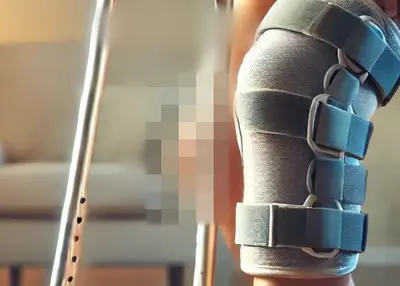72-year-old Michael, an avid gardener, who finally underwent knee replacement surgery after years of struggling with joint pain. Now that his surgery is complete, he’s eager to return to his garden, but first, he knows he needs to take special care of his new knee to avoid setbacks. If you’re like Michael or considering a total knee replacement yourself, knowing the right precautions post-surgery is essential to regaining your mobility without risking complications.
Understanding Why Post-Knee Replacement Precautions Are Important
Recovering from a total knee replacement requires more than rest—it’s about knowing what movements and activities can support healing and which ones can harm your new joint. Here are some of the key issues that may arise after surgery:
- Persistent Swelling: Even with successful surgery, it’s common to experience swelling around the knee for several weeks.
- Reduced Mobility: Stiffness can make it difficult to bend or move the joint naturally.
- Blood Clots: One of the most serious risks post-surgery, blood clots can form in the legs due to prolonged immobility.
- Infection Risks: Ensuring proper wound care is crucial to prevent infection around the surgical site.
Knowing these risks underscores the importance of following post-surgery precautions, which can ensure a smoother, safer recovery and protect your new joint.
Precautions After Total Knee Replacement: What You Must Know
To make the most of your knee replacement and reduce the likelihood of complications, it’s essential to follow key precautions. Here are some of the most important guidelines to keep in mind:
- Avoid High-Impact Activities
After your knee replacement, your joint is built to handle a range of low-impact activities, but high-impact exercises, such as running or jumping, can damage the implant. Stick to activities like walking, cycling, or swimming to stay active without putting unnecessary strain on your knee. - Stick to Your Physical Therapy Plan
One of the most important components of recovery is physical therapy. It’s not just about moving your knee, but about building strength in the surrounding muscles to support it. Skipping sessions or pushing yourself too hard can result in setbacks, so follow your therapist’s advice closely. - Be Mindful of How You Move
Everyday activities like getting out of bed or sitting down can strain your new knee if you’re not careful. Avoid twisting or pivoting your leg, and when sitting, use a chair with armrests to help you rise without putting too much pressure on the joint. - Use Assistive Devices When Needed
After surgery, you might need to use crutches or a walker for a period to support your weight and avoid stressing your knee. Transitioning to a cane or walking independently should be done gradually, as you regain strength and stability. - Prevent Blood Clots
Preventing blood clots after surgery is a top priority. Even simple exercises, like ankle pumps or gentle leg lifts, can improve circulation. Additionally, your doctor may prescribe medication to reduce the risk of clot formation. - Monitor for Signs of Infection
Keeping the surgical area clean is essential to avoid infection. Watch for warning signs like unusual redness, swelling, or drainage from the incision site. Contact your doctor immediately if any of these symptoms appear.
The Importance of Long-Term Care for Your New Knee
The first few weeks are critical for healing, but long-term care will ensure the health of your knee replacement for years to come. Here’s how you can protect your knee in the long run:
- Keep a Healthy Weight: Carrying extra weight can add stress to your knee, which may shorten the lifespan of the joint. Maintaining a balanced diet and staying active are key to preventing unnecessary strain.
- Stay Active, But Avoid Overexertion: Low-impact exercises like swimming, walking, or cycling help keep your knee strong and flexible without overloading the joint. However, be mindful not to push too hard, especially with activities that require heavy lifting or sudden movements.
- Take Care When Kneeling: Many patients can eventually kneel after their recovery, but you should avoid hard surfaces. If kneeling is unavoidable, use padded knee supports to protect your joint.
Outcome Story: Long-Term Success After Surgery
Let’s take the story of Diane, a 59-year-old nurse who underwent total knee replacement surgery after years of joint pain. She followed her physical therapist’s plan diligently, avoided high-impact activities, and adjusted her daily movements to protect her knee. Within a year, Diane was back on her feet, working long shifts and even hiking in her free time, all without pain or discomfort. Thanks to taking the right precautions, Diane’s new knee has given her a new lease on life.
Simple Precautions for a Stronger Recovery
A total knee replacement can be life-changing, but the key to success lies in how well you take care of your new joint. By following these essential precautions—staying active, being mindful of your movements, and sticking to your recovery plan—you’ll set yourself up for long-term success. Whether you’re just beginning your recovery journey or looking to maintain your new knee, these steps will help you regain your mobility and protect your joint for years to come.









